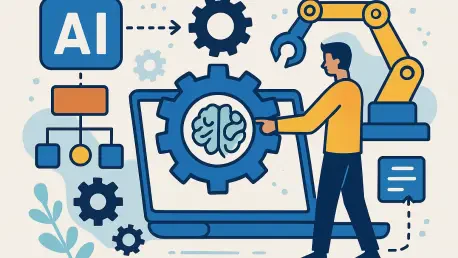In the fast-paced realm of software development and AI-driven automation, the challenge of managing complex, unpredictable tasks has become a significant hurdle for many organizations, demanding innovative approaches to stay competitive. Imagine a scenario where a development team faces the daunting task of refactoring legacy code across multiple files, with no clear predefined steps to follow. Traditional static workflows often falter under such variability, leading to inefficiencies and delays. This is where innovative solutions like LangGraph Orchestrator Agents step in, offering a dynamic approach to task management that adapts in real-time to the unique demands of each project.
The growing reliance on AI to handle intricate processes across industries underscores the need for systems that can think on their feet. LangGraph Orchestrator Agents address this need by introducing a central orchestrator that intelligently breaks down tasks, delegates them to specialized workers, and ensures a seamless final output. This technology promises to transform how teams approach automation, making it a critical tool in an era where adaptability is paramount.
This review delves into the intricacies of LangGraph Orchestrator Agents, exploring their core components, practical applications, and potential to reshape workflow automation. By examining their functionality and real-world impact, a clearer picture emerges of how this technology stands to benefit diverse sectors grappling with complex challenges.
Unpacking the Core Features
Central Orchestrator: The Brain of Task Management
At the heart of LangGraph Orchestrator Agents lies the central orchestrator, a large language model (LLM) designed to analyze incoming tasks with precision. Unlike rigid systems that depend on predefined steps, this component dynamically dissects inputs into manageable subtasks based on real-time assessment. Its ability to adapt to varying complexities ensures that no task is too unpredictable to handle effectively.
This dynamic planning capability sets the orchestrator apart from traditional workflow tools. By evaluating the scope and nature of a task on the fly, it identifies the necessary actions and prioritizes them accordingly. Such flexibility is particularly valuable in scenarios where requirements evolve during execution, ensuring the system remains responsive to changing needs.
The orchestrator’s role extends beyond mere task breakdown; it also serves as the coordinator for subsequent delegation. This ensures a streamlined flow of information to the appropriate specialized units, maintaining coherence throughout the process. As a result, the system achieves a level of agility that static workflows cannot match.
Specialized Workers: Executing with Precision
Once the orchestrator has mapped out the subtasks, specialized worker nodes—each powered by tailored LLMs—take over to execute specific components of the workload. These workers are designed to focus on niche areas, ensuring that each segment of a task is handled by an agent with the most relevant expertise. This targeted approach enhances the quality of outputs across diverse functions.
A key strength of these worker nodes is their capacity for parallel processing. By operating simultaneously on different subtasks, they significantly reduce the time required to complete complex projects. This scalability makes the system ideal for handling large-scale operations where efficiency is critical to meeting tight deadlines.
Moreover, the specialization of worker nodes contributes to overall system robustness. By assigning tasks to agents best suited for them, the likelihood of errors diminishes, and the consistency of results improves. This structured delegation fosters an environment where precision and speed coexist, optimizing performance at every stage.
Synthesis Mechanism: Crafting a Unified Result
The final piece of the puzzle is the synthesizer node, which aggregates the outputs from various worker nodes into a cohesive whole. This component ensures that the disparate contributions of specialized agents are integrated seamlessly, maintaining context and relevance in the final deliverable. Its role is crucial in delivering a polished outcome that reflects the intent of the original input.
Beyond simple aggregation, the synthesizer evaluates the collected results for coherence and accuracy. It resolves any discrepancies or overlaps between worker outputs, ensuring that the end product is not just a collection of parts but a unified solution. This attention to detail elevates the system’s reliability in producing high-quality results.
The synthesizer’s impact is evident in its ability to preserve the overarching narrative or purpose of a task. Whether the output is a comprehensive report, a refactored codebase, or a detailed blog, this node guarantees that the final result aligns with the initial objectives, providing a smooth transition from fragmented efforts to a singular, impactful conclusion.
Performance in Action: Building and Applying Workflows
Constructing a Dynamic Workflow
To understand the practical utility of LangGraph Orchestrator Agents, consider the process of building a workflow for generating a blog on a topic like “agentic RAG.” The initial step involves importing necessary libraries and loading a robust LLM, such as the qwen2.5-32b model from Groq, to power the system. This foundation enables the orchestrator to analyze the topic and outline sections like introduction, core concepts, and challenges.
Subsequent steps include defining structured outputs through Pydantic classes to ensure clarity in task delegation, alongside state classes to manage shared variables across the graph. Nodes are then established for orchestration, worker assignment, synthesis, and conditional logic, with the latter dynamically allocating workers based on the number of identified subtasks. This setup allows for parallel content creation, where each section is handled by a dedicated worker node.
The culmination of this process is the synthesis of individual contributions into a polished blog. The conditional node’s ability to scale worker allocation ensures efficiency, while the synthesizer guarantees a coherent final piece. This example highlights how LangGraph Orchestrator Agents adapt to creative and technical tasks alike, demonstrating their versatility in workflow design.
Real-World Impact Across Industries
The applications of this technology extend far beyond content creation, making significant inroads into software development and AI automation. In automated test case generation, for instance, the system can produce unit tests tailored to specific codebases, streamlining quality assurance processes. Similarly, it enhances CI/CD pipelines by ensuring consistent code standards through automated checks.
Other notable use cases include generating software documentation like UML diagrams for clearer project visualization, as well as aiding in legacy code refactoring by providing test coverage and modernization support. By reducing manual effort in these areas, the technology accelerates development cycles, allowing teams to focus on innovation rather than repetitive tasks. Such capabilities underscore its value in boosting productivity.
The broader impact on team collaboration and code maintainability cannot be overstated. By automating complex workflows, LangGraph Orchestrator Agents foster an environment where developers and stakeholders can work more cohesively, addressing challenges with greater speed and precision. This transformative potential positions the technology as a cornerstone for modern development practices.
Challenges in Adoption and Scalability
Navigating Technical Complexities
Despite its promise, adopting LangGraph Orchestrator Agents comes with certain hurdles, particularly in setup and integration with existing systems. The technical complexity of configuring orchestrator and worker nodes may pose a steep learning curve for teams unfamiliar with advanced AI frameworks. This initial barrier can slow down implementation in resource-constrained environments.
Integration challenges further compound the issue, as aligning this dynamic system with legacy infrastructure often requires significant customization. Organizations must invest time and expertise to ensure compatibility, which can delay the realization of benefits. Addressing these obstacles through streamlined documentation and user-friendly tools remains a priority for broader adoption.
Managing Scale and Consistency
Scalability presents another concern, especially when managing numerous worker nodes for expansive tasks. As the number of subtasks grows, ensuring efficient resource allocation and avoiding bottlenecks becomes increasingly difficult. The system must balance load distribution to prevent performance degradation under heavy workloads.
Consistency in accuracy across diverse use cases also warrants attention. While specialized workers excel in targeted areas, variations in task complexity or input quality can lead to uneven results. Ongoing refinements and community-driven updates are essential to mitigate these risks, ensuring the technology remains reliable as it scales.
Looking Ahead: Potential and Innovation
Evolving Capabilities and Integration
The trajectory of LangGraph Orchestrator Agents suggests a future rich with enhanced LLM capabilities and deeper integration with complementary AI tools. Advancements in model efficiency and reasoning are likely to bolster the orchestrator’s ability to handle even more intricate tasks, pushing the boundaries of automation. This evolution will further solidify its role in complex workflow management.
Integration with other platforms and technologies also holds promise, enabling seamless collaboration across ecosystems. From software development environments to data analysis tools, the potential to embed this system into varied workflows could redefine operational standards. Such expansions are poised to unlock new efficiencies from now through the coming years.
Expanding Horizons Beyond Tech
Emerging trends point toward applications in non-technical domains, such as content creation and strategic planning. The ability to dynamically orchestrate tasks in fields like marketing or education could democratize access to advanced automation, empowering professionals outside traditional tech spheres. This broadening scope reflects the technology’s adaptability to diverse challenges.
Speculation on long-term impact envisions dynamic orchestration as a standard for managing complexity across industries. As organizations increasingly adopt AI-driven solutions, systems like these could become integral to operational frameworks, driving innovation and responsiveness. The journey toward such widespread influence is already underway, shaping a smarter future.
Reflecting on a Game-Changing Tool
Looking back, the exploration of LangGraph Orchestrator Agents revealed a technology that redefined adaptability in AI workflow automation. Its ability to dynamically analyze tasks, delegate to specialized workers, and synthesize cohesive outputs marked a significant departure from static systems. The practical applications, from software development to content creation, demonstrated tangible benefits in efficiency and precision.
For organizations considering adoption, the next steps involve focusing on overcoming initial setup complexities through targeted training and robust support resources. Exploring pilot projects in specific use cases offers a low-risk way to assess impact, while collaboration with community-driven initiatives helps address scalability concerns. These actionable measures pave the way for smoother integration.
Beyond immediate implementation, the broader consideration is how to leverage this technology to foster innovation within teams. Encouraging experimentation with diverse applications and investing in continuous learning ensures that the full potential of dynamic orchestration is realized. This forward-thinking approach positions organizations to stay ahead in an ever-evolving technological landscape.









